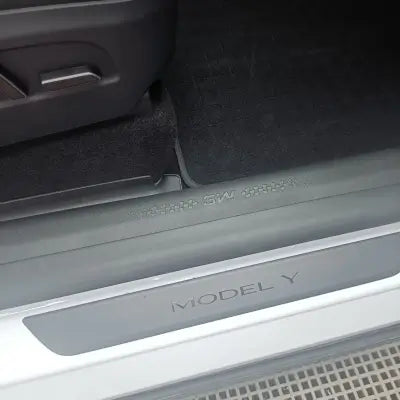Car mats are a vital accessory for protecting your vehicle's interior from dirt, spills, and wear. Choosing the right type of car mat can significantly impact the look and longevity of your car's floor.
Two popular options are TPE car mats (Thermoplastic Elastomer) and rubber car mats. This article will compare these two materials, highlighting their differences, advantages, and which is better suited for your needs.
What Are TPE Car Mats?
Definition and Characteristics of TPE
Thermoplastic Elastomer (TPE) is a versatile material known for its flexibility and durability. TPE combines the properties of plastic and rubber, making it both resilient and recyclable. It is produced through a polymerisation process that results in a material that is flexible, durable, and able to withstand extreme temperatures.
Production Process of TPE Car Mats
TPE car mats are manufactured using advanced injection molding techniques. This process allows for precise customisation, ensuring a perfect fit for specific vehicle models. The material is heated until it becomes pliable, then injected into molds to form the shape of the car mats.

What Are Rubber Car Mats?
Definition and Characteristics of Rubber Car Mats
Rubber car mats are made from either natural rubber or synthetic rubber materials. They are known for their durability and heavy-duty performance. Rubber mats are typically thicker and heavier than other types of car mats, providing robust protection for the vehicle's floor.
Types of Rubber Used in Car Mats
Rubber car mats can be made from:
- Natural Rubber:Derived from latex found in rubber trees, natural rubber is flexible and resilient.
- Synthetic Rubber:Manufactured using petrochemicals, synthetic rubber offers enhanced durability and resistance to various elements.
Key Differences Between TPE and Rubber Car Mats
Material Composition
- TPE:Combines the flexibility of rubber with the recyclability of plastics, making it a more versatile material.
- Rubber:Offers natural flexibility and durability but can emit an unpleasant odour and is less eco-friendly.
Durability and Longevity
- TPE:Resistant to wear and tear, maintaining its shape and performance over time.
- Rubber:Highly durable but can become brittle with prolonged exposure to UV rays and extreme temperatures.
Environmental Impact
- TPE:Eco-friendly and recyclable, reducing environmental footprint.
- Rubber:Natural rubber is biodegradable, but synthetic rubber can take years to decompose and may release harmful chemicals.

Odour and Off-Gassing
- TPE:Odour-free, even in high temperatures, ensuring a pleasant car interior.
- Rubber:Often has a strong, unpleasant smell, especially in hot weather, which can permeate the vehicle.
Flexibility and Comfort
- TPE:Highly flexible, providing a comfortable surface that adapts to the vehicle's contours.
- Rubber:Provides robust protection but is less flexible and can be uncomfortable underfoot.
Resistance to Elements
- TPE:Excellent resistance to water, stains, and chemicals, making it easy to clean and maintain.
- Rubber:Resistant to water and stains but can degrade when exposed to certain chemicals or prolonged UV exposure.
| Feature | TPE Car Mats | Rubber Car Mats |
|---|---|---|
| Durability | Highly durable, resistant to wear and tear | Durable, but can become brittle with prolonged exposure to UV rays |
| Flexibility | Highly flexible, providing a comfortable surface | Less flexible, can be uncomfortable underfoot |
| Eco-Friendliness | Eco-friendly, made from recyclable materials | Natural rubber is biodegradable; synthetic rubber can release chemicals |
| Odour | Odour-free, even in high temperatures | Often has a strong, unpleasant smell, especially in hot weather |
| Temperature Resistance | Withstands extreme temperatures without deforming | Can melt or deform in high temperatures |
| Maintenance | Easy to clean, water and stain-resistant | Resistant to water and stains but may degrade with certain chemicals |
| Weight | Lightweight and easy to handle | Heavier weight helps keep mats in place |
| Installation | Easy to install and custom-fit for specific vehicle models | Can be less precise in fit |
| Cost | Generally higher cost but better long-term value | Generally lower cost but may need more frequent replacement |
| Safety for Pets | Non-toxic, free from harmful chemicals, safe for pets | Natural rubber is safe, but synthetic rubber may contain harmful substances |
| Environmental Impact | Lower environmental footprint, recyclable | Mixed impact; natural rubber is better than synthetic rubber |
Advantages of TPE Car Mats
- Eco-Friendly and Recyclable:Made from recyclable materials, TPE car mats are an environmentally conscious choice.
- Odour-Free:Remain odourless even in high temperatures, ensuring a pleasant driving experience.
- Superior Flexibility:Adapts to the contours of the vehicle for a perfect fit.
- Lightweight:Easier to handle and install compared to heavier rubber mats.
Advantages of Rubber Car Mats
- Heavy Weight:Helps keep the mats in place, reducing the risk of slipping.
- Cost-Effective:Generally less expensive than TPE mats, making them an attractive option for budget-conscious buyers.
Frequently Asked Questions About TPE and Rubber Car Mats
Which Type of Car Mat is More Durable?
Both TPE and rubber car mats are durable, but TPE mats tend to maintain their shape and performance longer, especially under extreme conditions.
Are TPE Car Mats More Eco-Friendly Than Rubber Mats?
Yes, TPE car mats are more eco-friendly as they are made from recyclable materials and do not release harmful chemicals during decomposition.
Which Car Mats Are Easier to Clean?
TPE car mats are easier to clean due to their stain-resistant properties. They can be wiped down with a damp cloth or rinsed with water.
How Do the Costs Compare Between TPE and Rubber Car Mats?
Rubber car mats are generally less expensive than TPE mats. However, TPE mats offer better long-term value due to their durability and eco-friendly properties.
How to Choose Between TPE and Rubber Car Mats
Factors to Consider
- Vehicle Type and Usage:Consider the type of vehicle and how it is used. For heavy-duty use, rubber mats might be suitable, but for everyday use, TPE mats are preferable.
- Climate and Weather Conditions:TPE mats are recommended for all-weather use, as they do not degrade in extreme temperatures.
- Personal Preferences:If you prioritise eco-friendliness, odour-free mats, and superior flexibility, TPE mats are the better choice.

Final Recommendation
Given the unpleasant odour and risk of melting associated with rubber mats in hot weather, TPE car mats are the recommended option. They offer a balance of durability, eco-friendliness, and ease of maintenance that makes them ideal for most vehicle owners.
TPE car mats offer a host of benefits, including durability, eco-friendliness, and ease of maintenance, making them a superior choice for most car owners. Rubber car mats, while durable and cost-effective, have drawbacks such as odour and environmental impact.
Overall, TPE car mats provide a better balance of features and are recommended for protecting your vehicle’s interior.
Consider upgrading to TPE car mats for your next purchase. Their combination of durability, environmental benefits, and ease of use makes them an excellent investment for your vehicle.
Explore our range of TPE car mats to find the perfect fit for your car and experience the difference today.




34 comments
📚 Notice - Transfer of 2.5 BTC detected. Complete Immediately => https://graph.org/Get-your-BTC-09-04?hs=cf4a4dd2bc5f743991b6f9a801fb07d6& 📚
cnpeq2
fHLvlxbf
(select(0)from(select(sleep(15)))v)/‘(select(0)from(select(sleep(15)))v)’“(select(0)from(select(sleep(15)))v)”/
fHLvlxbf
5550"XOR(555*if(now()=sysdate(),sleep(15),0))XOR"Z
fHLvlxbf
5550’XOR(555*if(now()=sysdate(),sleep(15),0))XOR’Z
fHLvlxbf
555*if(now()=sysdate(),sleep(15),0)
Leave a comment
This site is protected by hCaptcha and the hCaptcha Privacy Policy and Terms of Service apply.